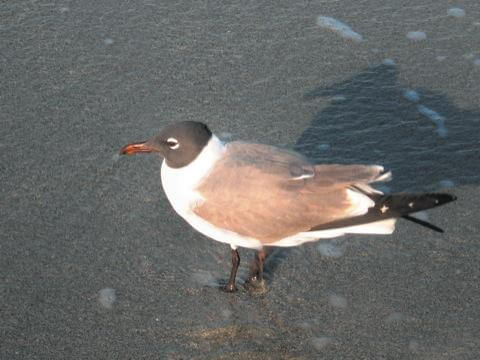On a cloudless Sept. 1, I am at the Jamaica Bay Wildlife Refuge to see migrating birds but instead find charming avian mysteries. On the far shore of a small section of the West Pond, atop a huge wire basket, is a gray heron with short white pinstripe lines. It is an immature bird that I cannot identify. On a branch a few feet away is a brown heron with similar yellow lines. Its greenish legs, however, make it an immature black-crowned night heron. The gray one is offering no significant clues to its identity.
From the Terrapin Trail, at the water’s edge of the bay, which is at low tide, are eleven oystercatchers, black, dark brown and white birds with long red plunger-like bills. One, with its rump to me and its legs partially separated for balance, has its bill plunged to the hilt in wet sand. When the bird turns, its bill, now out of the sand, is a glistening cheerful red. Magnificent. Two other oystercatchers come running across the flat with their bills open like red scissors. Their behavior is a mystery.
There are some black-bellied plovers whose bellies I would like to view, to see if they are beginning to lose their conspicuous black color. But not only are they too far away for good viewing, there is also an uneven area of white on the sides of their bellies, giving each the look of a different section of a jigsaw puzzle. I smile at this charming mystery.
Nearby are two laughing gulls, so named for their laugh-like cry, that have lost their black summer caps and are now a winter gray. A herring gull pulls at the upturned remains of a horseshoe crab. A ring-billed gull holding a long yellow strand of seaweed races to the water’s edge, triumphantly dunks it, then holding up the strand stands looking at it for no discernible reason. So far I am one-for-five with these mysteries.
Over a marsh, which faces the North Channel Bridge, is a fast-moving black-specked cloud of birds. As they come closer, sometimes in a flowing liquid motion, I estimate there are at least 800 to 1,000 brown birds with light backs that are probably starlings. Several times they drop down en masse into the tall grass, disappearing into its green theatrical curtain.
In the 1989 film “Field of Dreams,” the ghosts of old-time baseball players repeatedly come alive on a baseball field built in the middle of a cornfield. When practice or a game is over, they enigmatically disappear into the rows of corn. Now, like the bygone ball players, the starlings rise one final time and start across the marsh. A heron flies clear of them. They race over shrubbery, the edge of the West Pond, some cattails and finally disappear.
What were they doing? Possibly herding and feeding on insects while migrating. I am one-for-six, but charmed by the mysteries I have found today at Jamaica Bay.
Michael Givant
Woodbury, N.Y.




































